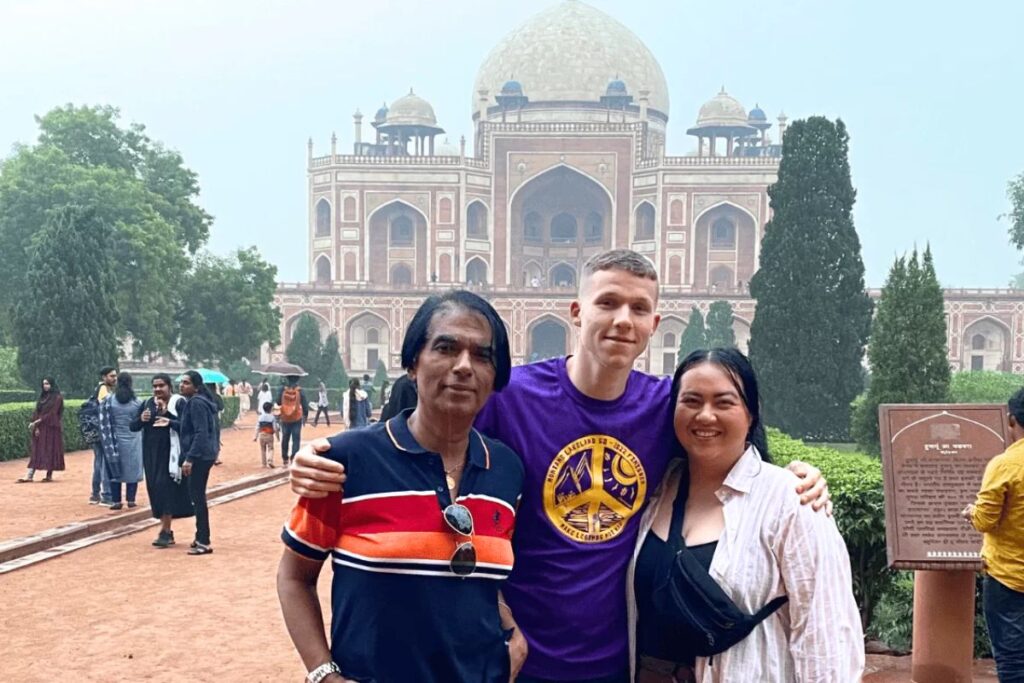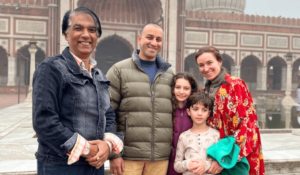Humayun Tomb Tour Guide – Discover Delhi’s Timeless Mughal Marvel, Step into the soul of Mughal history with Harry, your expert Humayun Tomb Tour Guide, and uncover the majestic beauty of this UNESCO World Heritage Site. Located near JLN Stadium Metro Station, the tomb is easy to reach and even easier to fall in love with.
Built in the 16th century by Empress Haji Begum for her husband Emperor Humayun, this stunning monument—Humayun ka Maqbara—is a true blend of Persian, Indian, and Islamic architectural finesse. Its graceful domes, red sandstone walls, and white marble detailing whisper stories of royal love, legacy, and timeless artistry.
Let Humayun Tomb Tour Guide walk you through its secret chambers, lush Charbagh gardens, and breathtaking Mughal symmetry while sharing tales that bring the stone to life. Don’t just visit—experience Humayun Tomb with a guide who makes history feel alive.
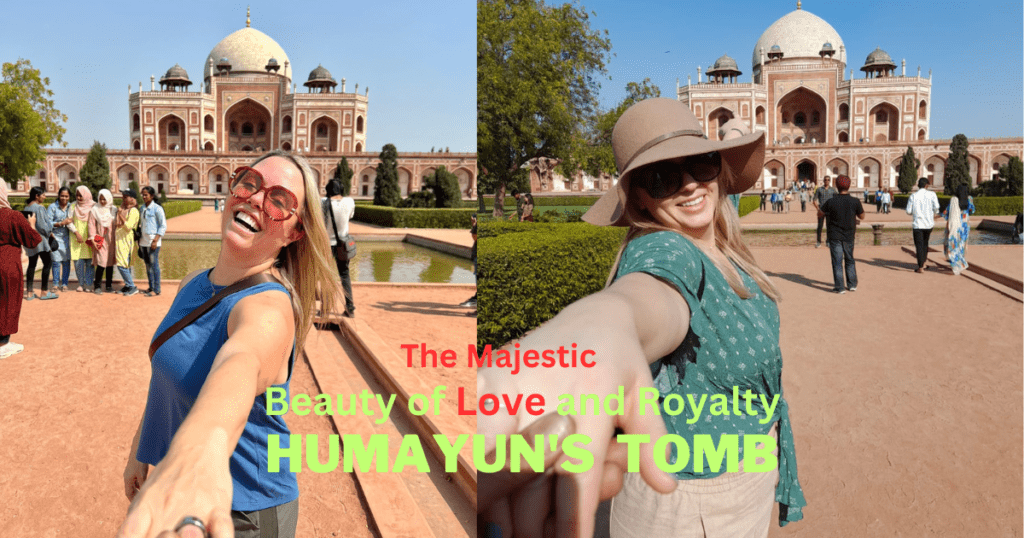
Humayun Tomb Tour Guide: Humayun Tomb History with a Local Expert
Humayun’s Tomb, famous for its stunning architecture built in 1570, holds immense cultural and historical significance. This garden-tomb, now a UNESCO World Heritage Site, stands as a pioneering example of Mughal architecture on the Indian subcontinent. Rich in historical depth, Humayun’s Tomb history reflects a unique era that blends Persian, Islamic, and Indian architectural styles. It is widely believed that the Taj Mahal, India’s most iconic monument, drew inspiration from this grand structure—a testament to love, beauty, and legacy. A Humayun’s Tomb tour guide can enhance your experience by offering insightful narratives about the monument’s fascinating history and architectural grandeur.
Humayun Tomb Tour Guide: Discover the Legacy of Mughal Grandeur
Explore the breathtaking beauty and timeless elegance of Humayun’s Tomb with an expert Humayun Tomb Tour Guide. Built in 1570 by Empress Haji Begum in memory of Emperor Humayun, this UNESCO World Heritage Site is a masterpiece of Mughal architecture. Often considered the inspiration for the Taj Mahal, the tomb blends Persian, Indian, and Islamic styles with stunning red sandstone and white marble details.
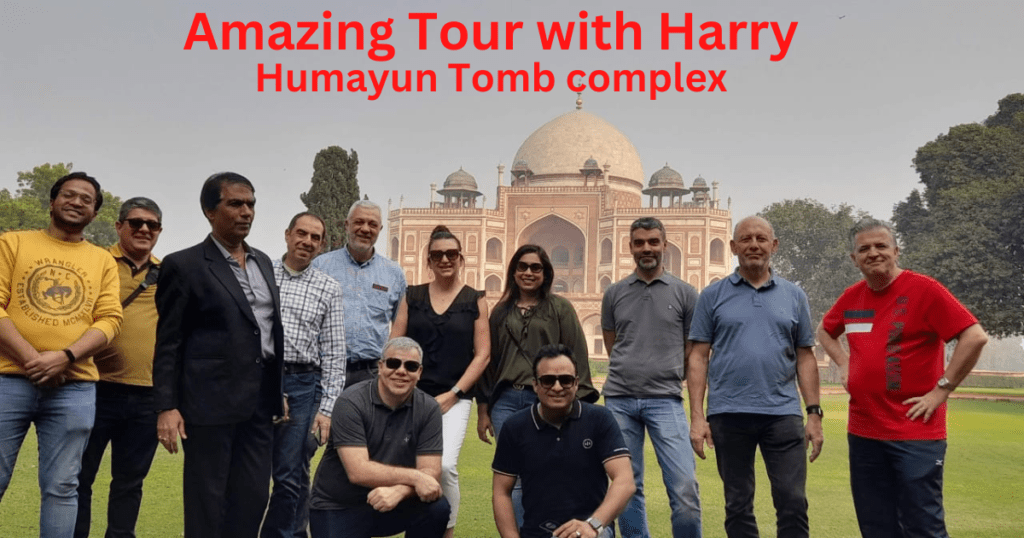
Explore the breathtaking beauty and timeless elegance of Humayun’s Tomb with an expert Humayun Tomb Tour Guide. Built in 1570 by Empress Haji Begum in memory of Emperor Humayun, this UNESCO World Heritage Site is a masterpiece of Mughal architecture. Often considered the inspiration for the Taj Mahal, the tomb blends Persian, Indian, and Islamic styles with stunning red sandstone and white marble details.

Wander through its historic Charbagh gardens, marvel at intricate carvings, and hear fascinating tales from Humayun Tomb History, including its role during India’s Partition. Watch it glow like moonlight each evening, a symbol of enduring love and royal heritage. Easily accessible from Jawaharlal Nehru Stadium metro station, this monument is a must-see on any Delhi itinerary.

History of Humayun by Tour Guide
Nasir-ud-Din Muhammad as Humayun was the second Mughal emperor who ruled the northern Indian in the 16th century. Humayun was born in Kabul on March 17, 1508, when Babur was trying to expand his empire. He accompanied him on his travels during his youth, and by the age of 18, he was with him at the Battle of Panipat (1526), one of the battles that established the Mughal Empire. They were later part of the Haras from Agra and were sent to settle the Ganges valley which is situated in the eastern part of the empire.

The journeys of Humayun and his father Babur are similar. Both gained territory and expanded it through military conquest and were then exiled. He conquered his territory using force and then died before organizing the empire. Humayun was kind and generous, though he was not a good general and warrior. He was also fond of painting and wrote poetry in Persian. He was a religious person, interested in astrology and art.
Delhi Tour Guide: Explore Old & New Delhi with a Local Expert
Explore Humayun Tomb Architecture with a Humayun Tomb Tour Guide
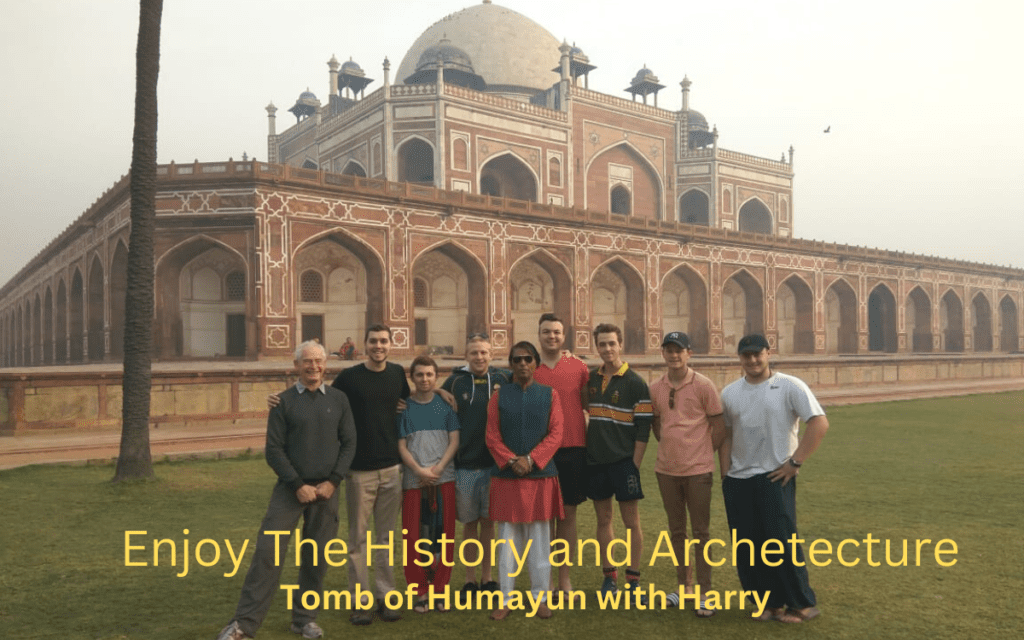
Step into a world of regal elegance and spiritual serenity with a Humayun Tomb Tour Guide, as you uncover the stories behind one of Delhi’s most iconic monuments. Built in the 16th century by Empress Haji Begum, the mausoleum was designed by Persian architect Mirak Mirza Ghiyas and later completed under the supervision of his son. Inspired by the Ghor-e-Amir in Samarkand, the tomb cost over one and a half million rupees and took eight years to complete.
Humayun Tomb’s Story is Similar to Taj Mahal Story in Agra.

An architectural masterpiece, Humayun Tomb architecture marked the beginning of garden-tomb design in India. Set in a stunning Charbagh (four-part) garden, the tomb is constructed mainly of red sandstone, with an elegant two-tiered white marble dome that rises 154 feet. The complex features 124 chambers, finely carved latticework, pavilions, water channels, and shady fruit-laden trees—creating a heavenly landscape inspired by the Quranic concept of Jannat (paradise).
Let a knowledgeable Humayun Tomb tour guide bring this Mughal marvel to life as you explore its octagonal chamber, Persian double dome, and the storybook setting of a royal afterlife. With seamless access from the JL Stadium metro station, your Humayun Tomb visit is just a step away from history and architectural brilliance.
In addition to the Emperor’s Tomb, several other tombs and monuments are part of the complex, including tombs of other Mughal royals like Emperor Jahandar Shah, Muhammad Kambakhsh Farrukh Siyar, Rafi-ud-Daulat, Rafi-ud-Darraj and Alamgir II. Tomb of Dara Shikoh, the eldest son of Shah Jahan
Humayun Tomb Tour Guide: Complete Information
Location: Mathura Road, Nizamuddin East
Timings: 6:00 AM to 6:00 PM; daily
UNESCO World Heritage Status
Entry fee: Indians: ₹30 by card, 40 by cash/ 550 for foreigners by Card, ₹600 by Cash
Photography: still camera: free
video camera: Rs 25
Nearest metro station: Jawaharlal Nehru Stadium , JorBagh
Humayun’s Tomb Delhi, It is also called: Humayun ka Maqbara
Appointed by: Humayun’s first wife Begum Begum alias Haji Begum.
Establishment year: 1565 to 1572
Architect: Merik Mirza Ghiyas and his son Syed Muhammad
Architectural style: mughal style
Construction cost: Rs 1.5 crore
Dimensions: 47 m (Height) x 91 m (Width)
The materials used: are red sandstone and white marble Black Marbel.
Things to See with Humayun Tomb Tour Guide

1. Isa Khan’s Tomb: Step beyond the grandeur of Humayun’s Tomb and explore Isa Khan’s Tomb, a stunning pre-Mughal octagonal mausoleum. Built during Islam Shah Suri’s reign, this gem of architecture houses Isa Khan Niazi and his family. Surrounded by a charming garden and an ancient mosque, it offers a glimpse into architectural styles that influenced later Mughal masterpieces. With a knowledgeable Humayun Tomb tour guide, uncover hidden stories and gain a deeper understanding of India’s rich history at this remarkable site.
2. Afsarwala’s Tomb and Mosque
3. A Humayun Tomb tour guide can help uncover the often-overlooked treasures surrounding the main mausoleum, such as the Tomb and Gardens of Bu Halima, a serene garden complex featuring a tomb set on a raised platform. Just outside the main boundary lies the Nila Gumbad or Blue Dome, an eye-catching octagonal mausoleum adorned with vibrant blue glazed tiles. Built by the son of a court courier during Emperor Akbar’s reign for his cherished servant Mian Fahim, this tomb is a hidden architectural gem. With its octagonal exterior and square interior walls adorned in painted stucco, it reflects the detailed craftsmanship of Mughal-era architecture. These lesser-known monuments enrich your experience when explored with an expert guide.
6. Chilla Nizamuddin Auliya: A Humayun Tomb tour guide can take you beyond the main mausoleum to explore hidden historical gems like Chilla Nizamuddin Auliya, the serene residence of the revered Sufi saint and Delhi’s spiritual patron, Nizamuddin Auliya. This Tughluq-era masterpiece, located at the northeastern end of the complex, offers a glimpse into the saint’s spiritual legacy and Delhi’s rich Sufi traditions.
7. Barber’s Dome, Another fascinating site is the Barber’s Tomb or Nai Ka Gumbad, tucked away in the southeastern section of the garden. Surrounded by the traditional Charbagh layout, this modest tomb from 1590-91 AD honors the royal barber of Emperor Humayun. Its proximity to the emperor’s own tomb speaks volumes about his favored status in the royal court. These lesser-known monuments come to life when explored with a knowledgeable tour guide, adding depth to your journey through Mughal history.
8. Tomb of Hamida Begum, one of Humayun’s wives and Akbar’s mother
Humayun Tomb Timings and Ticket
Humayun’s Tomb timings are from 6 AM to 6 PM. Humayun Tomb entry fee is Rs 30 for tourists from Indian cities and SAARC countries (Bangladesh, Nepal, Bhutan, Sri Lanka, Pakistan, Maldives and Afghanistan) and BIMSTEC (Bangladesh, Nepal, Bhutan, Sri Lanka, Thailand and Myanmar). While the ticket price for tourists other than these countries is Rs. 550 card or 600 cash per person
Humayun Tomb Nearest Metro Station
JLN Stadium on the Purple Line is the nearest metro station to Humayun’s Tomb, just 2 km away. You can either drive an auto rickshaw or walk on a suitable weather day. The next closest is Jorbagh Metro Station on the Yellow Line, which is about 5 km from Humayun’s Tomb. Take a radio taxi or auto-rickshaw, and you’ll be there in 15 minutes.
Humayun Tomb Nearest Bus Stand
Buses operated by the Delhi Transport Corporation (DTC) stop at strategic locations in the city. All public transport buses stop at Nizamuddin Police Station which is about 900 meters from Humayun’s Tomb.
Humayun Tomb Nearest Railway Station
Nizamuddin Railway Station is the nearest railway station to Humayun’s Tomb at about 2.2 km. There are plenty of auto rickshaws available from the station to take you to the monument. Depending on the city you are coming from, you will find many trains that stop at Hazrat Nizamuddin.
Humayun’s Tomb Tour Guide

Harry is an outstanding Humayun’s Tomb tour guide, making the historical journey an unforgettable experience. His deep knowledge of the monument’s history and architecture adds immense value to the tour, offering fascinating insights and stories that bring the site to life. As a Humayun’s Tomb guide, Harry’s passion for the subject is evident in his engaging narrative, making the visit not just informative but also enjoyable. His ability to navigate the complex seamlessly, pointing out intricate details and sharing anecdotes about the Mughal era, showcases a level of expertise that enhances the overall experience. With a friendly demeanor and a knack for storytelling, Harry creates a welcoming atmosphere, ensuring visitors leave with a profound understanding and appreciation for Humayun’s Tomb. Highly recommended for an enriching and delightful exploration of this iconic historical landmark.

Harry is the perfect Humayun Tomb tour guide, turning your visit into a fascinating journey through Mughal history and architecture. With deep insights and engaging stories, he reveals hidden gems and untold tales, making every moment memorable. For a truly enriching experience at this UNESCO World Heritage Site, touring with Harry is a must.
Humayun Tomb Nearby places to See
Just a short stroll from Humayun’s Tomb lies Lodhi Garden, a peaceful green retreat dotted with centuries-old tombs from the Delhi Sultanate. With striking monuments like those of Muhammad Shah and Sikandar Lodhi, this garden offers a quiet yet majestic escape into Delhi’s layered history. A knowledgeable Humayun Tomb tour guide can help you explore both sites in one enriching journey—connecting the grandeur of Mughal architecture with the timeless charm of Lodhi Garden.
Nizamuddin Dargah near Humayun Tomb Tour Guide
Just steps away from the grandeur of Humayun’s Tomb lies the soulful Hazrat Nizamuddin Dargah, a serene Sufi shrine dedicated to the revered saint Nizamuddin Auliya. With a Humayun Tomb tour guide, you can experience not only the majestic Mughal architecture but also the spiritual essence of Delhi. Let the mystical qawwalis and sacred ambiance transport you into the heart of India’s spiritual heritage.
Khan e Khana’s Tomb near by with Humayun Tomb Tour Guide
Just a short walk from Humayun’s Tomb, the mausoleum of Abdul Rahim Khan-e-Khana stands quietly on the banks of the Yamuna. A poet, statesman, and trusted minister in Emperor Akbar’s court, Rahim’s tomb is steeped in Mughal legacy. With a knowledgeable Humayun Tomb tour guide, you’ll discover how his garden once stretched to Humayun’s Tomb, linking two great figures of India’s golden age through landscape and history.
